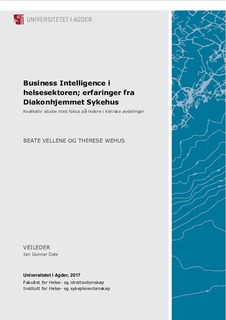| dc.contributor.author | Vellene, Beate | |
| dc.contributor.author | Wehus, Therese | |
| dc.date.accessioned | 2018-03-13T11:50:43Z | |
| dc.date.available | 2018-03-13T11:50:43Z | |
| dc.date.issued | 2017 | |
| dc.identifier.uri | http://hdl.handle.net/11250/2490281 | |
| dc.description | Masteroppgave i helse- og sosialinformatikk HSI500 - Universitetet i Agder 2017 | nb_NO |
| dc.description.abstract | Background: It is challenging to manage hospitals in Norway, partly due to changing economic frameworks and new demands from the government. Various information technologies are used in the health care system and many projects fail. Adoption of new technology is difficult in a complex organization with many different professional groups. Purpose: The purpose of this study is to investigate managers experiences with using a management information system (MIS) in clinical departments at a hospital in Norway. The system is self-developed at the hospital and is used by all levels of management. The aim is to investigate how the system is used in clinical practice and whether management information is used to support decision making for future challenges or as a control to explain the difference between planning and action. Selection and methodology: A case study was carried out at the hospital using qualitative methods; nine interviews were conducted with clinical managers. A semi-structured interview guide was created based on DeLone and McLean’s model (2003). In addition, document analysis of the hospital's own documents was conducted as well as background conversations with the system developer of the MIS. Results: There is a large variation in the use of the system and the informants have different views on the information quality. The informants who have participated actively in the development of the system are more satisfied. A strong user involvement has made the system very complex and several informants have difficulty exploiting the system’s full potential. This leads to a distrust of the numbers that influence usage. None of the informants have received training, but everyone experienced that the system simplifies their work and are positive to the implementation. The system to some extent covers the needs for control and overview. The system is not frequently used in the clinical everyday life. Conclusion: The system cannot fully capture the complexities of everyday life and make it visible to management. The system is not a clinical decision support system, but a system that collects retrospective management data from multiple sources. This helps to highlight operational challenges and simplifies reporting. The informants experience having greater ownership by retrieving the numbers themselves. A clearer strategy from the hospital and organized training could reduce the burden on user support and enhance management skills and user satisfaction. Keywords: Management Information System, Decision Support, Management Tools, Business Intelligence, Health Care, Hospital, Evaluation | nb_NO |
| dc.language.iso | nob | nb_NO |
| dc.publisher | Universitetet i Agder ; University of Agder | nb_NO |
| dc.rights | Attribution-NonCommercial-NoDerivatives 4.0 Internasjonal | * |
| dc.rights.uri | http://creativecommons.org/licenses/by-nc-nd/4.0/deed.no | * |
| dc.subject | HSI500 | nb_NO |
| dc.subject | Management Information System | nb_NO |
| dc.title | Business Intelligence i helsesektoren : erfaringer fra Diakonhjemmet Sykehus Kvalitativ studie med fokus på ledere i kliniske avdelinger | nb_NO |
| dc.type | Master thesis | nb_NO |
| dc.subject.nsi | VDP::Teknologi: 500::Informasjons- og kommunikasjonsteknologi: 550 | nb_NO |
| dc.source.pagenumber | 94 s. | nb_NO |

